2 Dare2Dialogue: Promoting Inclusion Through Storytelling and Dialogue
Amber E. Kelly, Ph.D.
Kathleen E. McAuliff, Ph.D.
The chapter will share insights on this innovative strategy for promoting inclusion among individuals with a disability using community dialogue and events.
The Big Picture
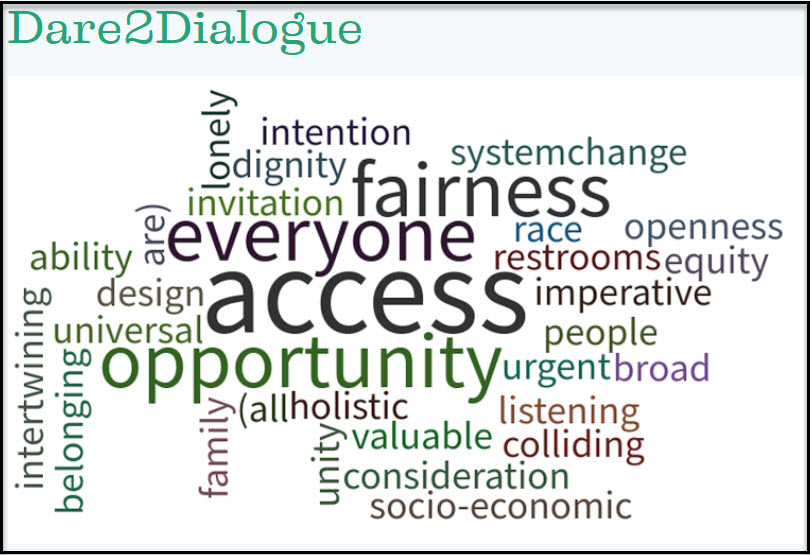
According to the World Health Organization (WHO), more than 1 billion people live with a disability (WHO, 2017). Globally and nationally, disabilities are more commonly found in areas of poverty. Approximately 26% of people in the U.S. have a disability, with the most common disabilities being related to mobility or cognition (Okoro et al., 2018). As people live longer, they are more likely to experience a disability (Bialik, 2020). Although there is a higher prevalence of disability than some might guess, individuals with a disability still experience adverse outcomes when compared to individuals who do not have a disability, including reduced access to healthcare, educational, and employment opportunities (Okoro et al., 2018). While the causes of these adverse outcomes are multi-faceted, one potential avenue for positive social change is increasing visibility and educating the community about the experiences of people with disabilities. While overall perceptions are changing, there are still many myths about disabilities. One of the most common myths is that all disabilities and chronic conditions are visible.
In fact, 96% of people with a chronic condition do not have a condition that is visible, and 73% of people with a severe disability do not use a personal assistive device such as a wheelchair or walker (Disabled World, 2020). Educating people through first-hand experiences can help dispel these myths, and illuminate ways in which the community could change to promote inclusion for people with disabilities. To move our theoretical framework of awareness and storytelling to practice, we sought funding and begin to put the project together. See highlights below of statistics regarding disabilities:
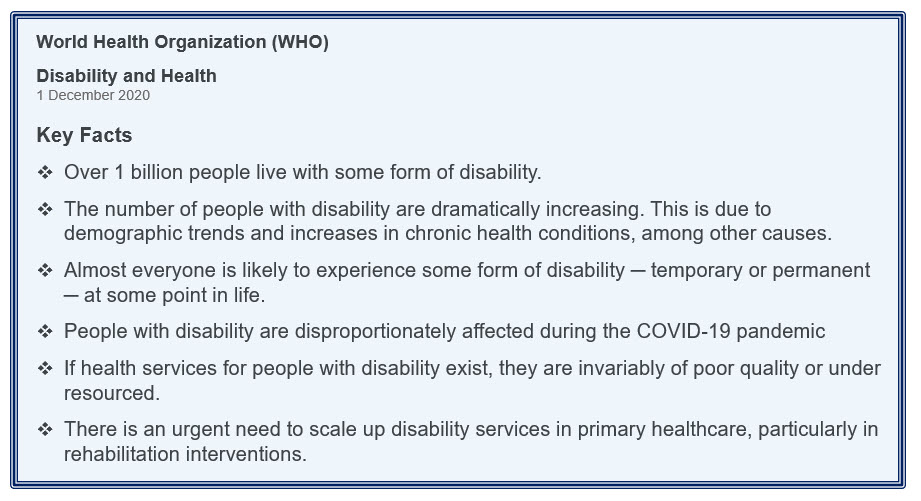
The goal of Dare2Dialogue was to bring awareness and engage in storytelling around challenging topics to promote change, specifically focused on individuals with a disability as a means to remove the negative stigma that can be associated with a disability. This goal was initially achieved by having two individuals who live with disabilities share their stories to highlight challenges and encourage dialogue among those who may have the privilege of not living with a disability. Subsequently, three community discussions (including one documentary screening) created an opportunity for 96 Dare2Dialogue attendees to challenge their thinking around inclusion. The chapter will share insights on this innovative strategy for promoting inclusion for individuals with a disability among community events.
Community Needs
Traditionally, local organizations that serve individuals with a physical or cognitive impairment ensure that events prioritize ability. Some examples used in hosting events include using locations that are wheelchair accessible and having sitting space for caregivers. Organizations share a challenge of attracting others to attend that typically do not attend ability-focused events. Attendees are ability advocates, and there is an interest in broadening the audience’s diversity when it pertains to interest in ability-related issues. One local initiative emphasizes inclusion through the medium of film (Over The Rhine International Film Festival, 2021). With an open door to help close this gap in initiatives that focus on living with a disability, there were opportunities to create additional events. Further, People’s Liberty was a philanthropic lab that awarded 120 visionaries grants to impact their community in an innovative way. The five-year initiative focused on empowering individuals to help improve communities’ well-being where they lived and thrived. At the 2.5-year mark of this initiative, People’s Liberty hosted a midway celebration, “Intermission”, which allowed for twenty grantees to host an innovative event in a storefront space. The first event using this storefront space was the pilot for Dare2Dialogue, and it was the only event during the series that focused on the inclusion of individuals living with a disability. It was one of the most attended events during the celebration, which prompted the development of additional events in ability.
Collaborative Partners
When selecting collaborative partners, they should share the collective vision for promoting the inclusion of individuals living with a disability. Community Engagement Collective (CEC) partnered with Starfire, an organization focusing on empowering leaders to build community and inclusion alongside people with developmental disabilities and People’s Liberty using their storefront building as the venue for all Dare2Dialogue events.
Language Matters
Using language that does not demean a population is critical to consider for working within community settings. The disability field has evolved in terms of the preferred language and continues to grow. The American Psychological Association (2019) recommends using language to promote solidarity, respect, and ultimately honor all individuals as human beings. First-person language focuses on the individual, while individual first language emphasizes the disability. Dunn and Andrews (2015) make a case for using both first-person and identity-first language when doing work in the disability field and taking a flexible approach is respectful. Ultimately, using the term preferred by the individuals with the lived experience is the best option (American Psychological Association, 2019).
What Does Inclusion of Individuals with a Disability Really Mean?
Inclusion ensures that people with disabilities have their voices and experiences heard by people who may not see the same barriers or opportunities that exist in a community. If only people without disabilities are making decisions, certain barriers and opportunities may not be identified, thus excluding vital community members. For example, a community may not offer physical public spaces which are ADA (Americans with Disabilities Act) compliant, or a library may not offer spaces for people with sensory processing disorders, such as autism spectrum disorder. As no two people without disabilities are the same, people with disabilities are not a monolith, even if they have the same type of disability. Different disabilities bring different strengths and challenges, so creating an inclusive environment where all voices can be respected and heard is critical. Because most people do not have a disability, openness to learning and listening is imperative to make our communities truly inclusive and create larger community change. Storytelling in diverse settings allows speakers to share their stories and make connections with others that may not have previously had the opportunity.
Storytelling and Inclusion
One method of including individuals with disabilities is through storytelling. Storytelling allows people with disabilities to share their experiences in a structured format where participants actively listen to another person’s experiences. One of the 10 principles, that is key to intergroup relations is to provide opportunities for members of different groups to get to know one another as individuals (ASDC for the Community Foundations/Intergroup Relations Program, 1999). Through listening to individual stories from people with disabilities, people without disabilities can put a face to an experience, rather than stereotyping. Additionally, it also provides an opportunity for people to build a sense of community with one another. Storytelling is a unique type of participatory action research method that empowers a participant to shape and share their own narrative, communicating the truth and emotional impact of their experiences (Bailey & Tilley, 2002). Without using prompts or being guided by a researcher’s agenda, participants with disabilities can decide which event(s) and experiences they can share.
Community conversations are another method of bringing together people with disabilities and people without disabilities (Carter & Bumble, 2018). Community conversations use an asset-based focus, solution-focused framing, awareness building, and a shared commitment to improving the community for individuals with disabilities. While storytelling and community conversations are similar, storytelling was selected for this event so that the focus could be on the speakers with disabilities sharing their experiences and shaping the narrative to promote awareness, so that the community members could listen, reflect, and, for some, redefine the ways they perceived someone with a disability.
Dare2Dialogue’s Linkage to Community Psychology Practice
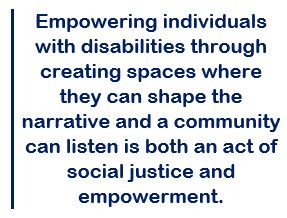 Dare2Dialogue fused together community conversation and storytelling (Dare2Dialogue, 2021) through the use of multiple principles of community psychology. Community psychology explicitly states a sense of community, respect for human diversity, social justice, and empowerment/citizen participation as some of its core values (Prilleltensky & Nelson, 1997). This particular event is focused on fostering a sense of community through including and listening to the experiences of individuals with disabilities. As inclusivity is often lacking for people with disabilities, creating a sense of community where everyone feels like they belong requires community members to understand the ways in which they (individually, interpersonally, or as a community) may be excluding community members who have disabilities. Furthermore, as disability is a type of diversity, it is also important that people with disabilities are represented and respected in the community. As mentioned earlier in this case story, individuals with disabilities often experience adverse outcomes because of social injustices, such as reduced access to employment, education, and discriminatory practices.
Dare2Dialogue fused together community conversation and storytelling (Dare2Dialogue, 2021) through the use of multiple principles of community psychology. Community psychology explicitly states a sense of community, respect for human diversity, social justice, and empowerment/citizen participation as some of its core values (Prilleltensky & Nelson, 1997). This particular event is focused on fostering a sense of community through including and listening to the experiences of individuals with disabilities. As inclusivity is often lacking for people with disabilities, creating a sense of community where everyone feels like they belong requires community members to understand the ways in which they (individually, interpersonally, or as a community) may be excluding community members who have disabilities. Furthermore, as disability is a type of diversity, it is also important that people with disabilities are represented and respected in the community. As mentioned earlier in this case story, individuals with disabilities often experience adverse outcomes because of social injustices, such as reduced access to employment, education, and discriminatory practices.
Description of the Project
Dare2Dialogue Series on Inclusion consisted of events where an individual (or individuals) with a disability shared their experiences with the larger community, including people without disabilities, in order to educate, enlighten, and promote dialogue about community inclusion for people with disabilities. The series included three distinct events which are: (1) storytelling from the perspective of someone living with a physical disability, (2) storytelling from the perspective of living with a cognitive disability, and (3) movie screening sharing the lives of individuals with a disability.
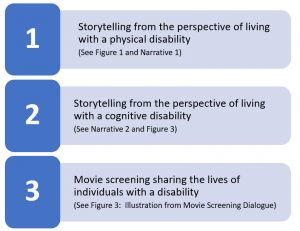
For recruitment, a snowball sampling strategy was used (Noy, 2008). A snowball sampling strategy is commonly used in qualitative research and involves one participant using their network (i.e., people they know) to recruit additional participants. It is particularly useful in populations that may be difficult to reach or recruit. In some cases, a researcher will ask the participant to provide the contact information for additional potential participants to facilitate recruitment. In other cases, the initial participant(s) will recruit the potential participants, as they already have an established relationship. This event used the latter method for recruiting participants. Each event took place in the same venue, located in downtown Cincinnati, Ohio, close to public transportation, and was accessible. The first event took place during lunchtime, and the second and third events took place in the evening. When arriving at the first two events, attendees received a card to complete a word cloud. For word clouds, the statement should allow for a one-word response only. The same prompt was used. Below is a picture of a cloud with the prompt in it which says, “in one word what comes to mind when you think about inclusiveness?
Attendees had the option of texting their response, completing via website link, or sharing their reactions with a volunteer. A Quick Response (QR) code on the card helped to make the connection to the link easier. The word cloud was shown on a projector for attendees to view. Before the community member spoke, the guests enjoyed free food and drinks since it was close to mealtimes. Attendees took the time to mix and mingle before each event to facilitate community building.
Physical Ability
Word Cloud from 1st Event
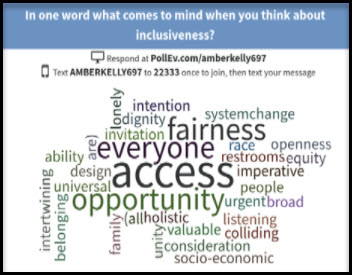
Image above is a “word cloud” or collage of words such as fairness, access, opportunity, ability…
Narrative One
Speech from 1st Event
Hello everyone, I would like to start by thanking everyone for showing up for our discussion on inclusion in a midwestern city. So for starters, what is Inclusion? According to Webster, it’s the act of or state of being included. That’s it, it’s just that simple. Now add people to inclusion and it becomes much more convoluted because every one of us is different. Just take a look around the room and you can see the diversity here. Every one of us has multiple qualities that make us unique, be it our physical differences such as our height, color of our skin, body shape, hair, you name it. But we also have different nonphysical qualities which aren’t so prevalent, such as our upbringing, education, and financial backgrounds, the way we process information, biases, etc. There is no cookie-cutter form of inclusion that will work for everyone so inclusion will look different in different settings. For example, at my job, I am the only person there who doesn’t have to walk anywhere. Steps… pssh I’m not walking up steps. I have my own way of getting around and it doesn’t cause me to burn much energy. Just look at this bad boy. 2 all-terrain front wheels, good for climbing obstacles, fog headlights, padded leather back and armrests, and a hydraulic system that’d put most low-riders to shame. It doesn’t get any better than this.
“This is an awesome chair but I haven’t always been this blessed, over 9 years ago I used to have to walk like you all until one morning as I was riding my bicycle to my job at the hospital and was hit by a guy making a left turn who didn’t see me”.
I spent the next 6 months learning how to breathe on my own again, I was determined not to have to be dependent on a ventilator for the rest of my life. So when they tested to see if I could breathe on my own, I’d do it until I couldn’t take it anymore. Each time I’d go a little longer. I relearned how to eat without choking because I was on a feeding tube for 3 months. You never know how much you actually miss chewing and tasting food until you can’t anymore. Just being able to suck on small pieces of crushed ice was a treat. Eventually, I learned to feed myself, and I was able to strengthen my muscles enough to go home.
All of these tasks were difficult but I would prefer them over not being able to see my daughters for 3 months. You see, my accident happened during “flu season” at the hospitals, and during that time children aren’t allowed past a certain point. Thankfully, I had my family who brought me pictures of them. It wasn’t the same as seeing them in person but it was better than nothing. My family helped tremendously with my recovery so when I think of inclusion, I think of FAMILY because to be included in a group sometimes can be like gaining a new family.
After my accident, I saw my city differently. I became aware of how inaccessible it really was. I have come across sidewalks that I cannot access so I had to ride in the street with busy traffic, businesses without a ramp or elevator. Transportation for wheelchair users is inconvenient. I began thinking of ways to improve the city in that arena, but I didn’t have to think I could change anything alone nor did I have the resources, nor did I know where to start because all of this was still new to me, so my ideas were placed on the back burner. It wasn’t ‘til I interviewed at my job that I started back thinking about Inclusion. Because when I went for my interview, I needed help getting inside because there weren’t any automated doors. My now Supervisor asked if I saw any obstacles for me to work there and the doors were my only issue. Within a few months, plans were in place for an automated door to be put in and now it is truly accessible all because of the pebbles I threw in the pond. So I’ve learned that little things can cause big ripples and that my city is ready for change.
Cognitive Ability
Narrative Two
Speech from 2nd Event
I was born 3 months premature. Doctors thought I would not be able to walk (paralyzed). I weighed 1lb. Mom said she could fit me in the palm of her hand). My disability is called cerebral palsy. I have 1 older sister and 2 younger brothers. It is hard being the oldest brother with a disability because I thought I would be the first one to do everything like drive. I do not like asking people to do stuff for me because I feel like I can do it all on my own. But we all need help sometimes.
Elementary School
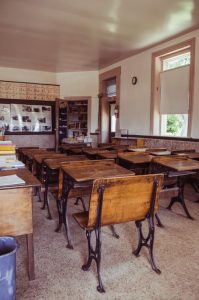
My mom asked me did I want to go to a regular school or a school for people with disabilities. My answer was a regular school. I wanted to go to a regular school because I felt like I had to do it. I had a choice. Everyone does not have a choice. Sometimes people make the choice for you. When I came home from school one day, I asked my sister “Why am I different?” She did not have a response to my question. Her mind was puzzled. I asked her because I wanted to know what her response would be. Later, I was bullied in the 1st grade. A student at school picked on me. I stood up for myself. It felt good. Today, I do not like seeing people getting picked on.
I played football as a kid. I played football ages 7-12 (except age 9). It was important for my dad to coach me so I could feel like a regular kid. I loved having my dad coach me because he understood me. I loved playing football. When I was 10 years old, my 7-year-old brother played in a game with me. I remember I asked my brother did he want to fill in because we did not have enough players to play that game. He said “Yeah.” I said, “These are 10-year-olds, you are 7, are you sure you want to play?” I asked him twice. He said “Yeah.” He held his own and he made tackles. I was proud of my little brother. At 7 years old, I would fall to the ground so I wouldn’t get tackled. I played basketball too and my dad coached me as well. I was a better basketball player than a football player.
Gym Class Story
This one particular afternoon in school, the gym teacher had asked me to jump rope. My response was no because I did not feel comfortable jumping rope in front of the whole class. I felt embarrassed to be put on the spot like that because she knew of my circumstances. I was upset and that was the hardest thing I went through as a child. It felt great to have my classmates have my back. They asked the teacher why she had me jump rope in front of the whole class when she knew of my circumstance. She did not have a response.
Junior High School
When I first went to Junior High School, I was nervous because it was a new environment. I did not know how I would adapt to the new place. Being accepted in the National Honor Society was an excellent thing. It was great to realize that I was doing good in school. However, in the 7th grade, there was a teacher who did not want to modify the work for me in my social studies class. To avoid the problem, I just went to a special education social studies class instead. I was disappointed because I wanted to be in a regular social studies class with all of my friends.
High School
I had a wonderful person that scribed for me and helped me with my thoughts. She worked with me since junior high school. The gym teacher was nice. She was very understanding and helpful. My senior year was the most exciting out of my 4 years of high school because I got to participate on the football team. I wanted to motivate people and be an encourager. I did not let anything stop me from doing what I wanted to do. Graduation was emotional. I thought about all the things from elementary school from when teachers did not want to modify my work to graduating high school. I felt like I had completed my goal to graduate from high school.
StarfireU
I wanted to do StarfireU because it was exciting and a 4-year program. I was the youngest in the program. It helped me to learn how to communicate with others. It helped me realize how to be a good friend to people. I learned how to make sure everybody felt like they were included. I remember a few times in the building some people would ask me to pray for them. I would take them to a room and pray for them. This is how I found my calling.
My Calling
My calling is to preach in ministry. It was hard at first to accept the calling because I did not know if people would accept me because of my disability. There were a lot of sleepless nights struggling to accept my calling. Once I accepted my calling, it felt great. The goal of my sermons is to encourage people to be great. I want to let people know they should live life to the fullest and be great at what they do.
Movie Screening
For the final event, a movie screening, which was a collaboration between two local nonprofit organizations Starfire and Community Engagement Collective took place. Partnering organizations shared the event on their social media platforms. Attendees enjoyed fresh popcorn and pizza before the movie. The previous event used in-person storytelling as the foundation; however, this event used movies as a form of art. The movie Wretches and Jabberers follows protagonists Tracy and Larry as they travel the world sharing their advocacy message for individuals with autism. After the movie, attendees discussed their reactions to the film in small groups. Some of the group sharing included statements like “Having my voice heard is life-changing,” “More like you than not,” and ” The humanity of acceptance.” (See Figure 3)
Figure 3 Illustration from Movie Screening Dialogue
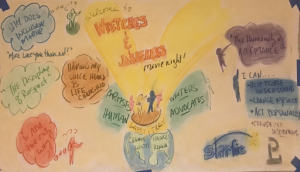
Outcomes and Impact
The goal of Dare2Dialogue was to bring awareness and engage in dialogue around challenging topics to promote change (See Figure 4). The purpose of the community discussions on inclusion was to bring awareness to the lack of inclusion of individuals with a disability using storytelling, community conversations, and movie screening. After the launch of the Dare2Dialogue inclusion series, the community partners collaborated on various initiatives including training, speaking engagements, and conference planning. The common thread of these initiatives focused on the inclusion of individuals living with a disability. Figure 4 below shows that in the program, there were 96 attendees, 3 events for the purpose of bringing awareness to the importance of inclusion.
Figure 4: Impact of Dare2Dialogue Inclusion Series

Lessons Learned
We learned through this process three important factors: (1) Do not use identity-first language (e.g., disability), (2) partner with other organizations for hosting events, and (3) engage audience members in multiple ways.
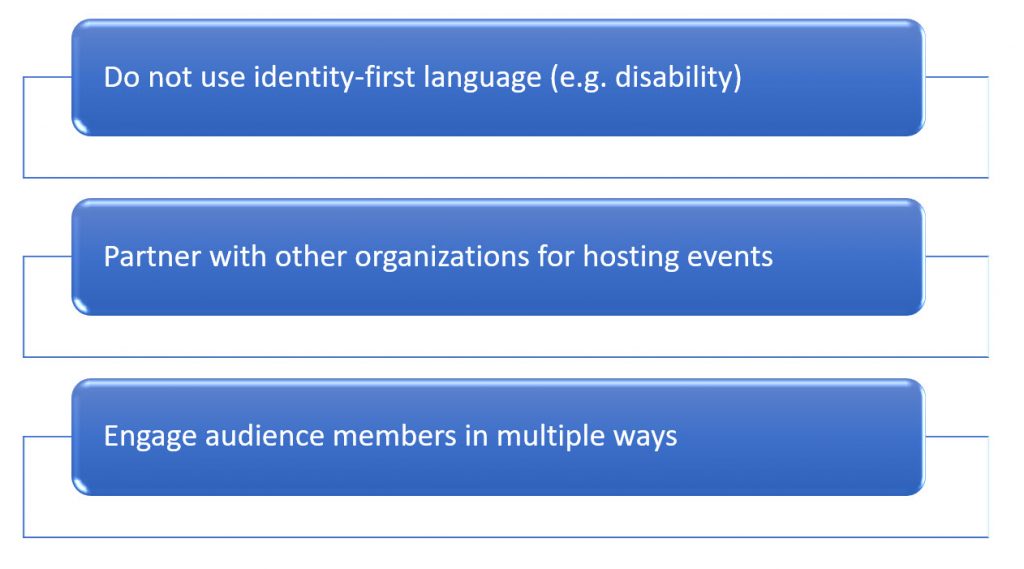
Hosting three different events gave insight into how to plan future events that emphasize individuals of diverse abilities. When striving to foster inclusion within events, it is important not to label the event with disability or ability. This limits the diversity of audience members in attendance. In turn, the conversation’s potential impact is limited because the audience members tend to understand the issues within the ability space. People are creatures of habit and tend to participate in events that address a topic of interest versus an unfamiliar issue. For instance, ability advocates are more likely to attend events that focus on ability. To target non-advocates, use terminology that describes the event’s activities, not the storytellers and or community members. For example, if a storyteller is living with autism and is sharing gardening, emphasize gardening in marketing materials. In this example, the audience members will build connections due to the collective interest in gardening, not autism. Example words can include diversity, inclusion, conversation, storytelling, dialogue, and community connections in event marketing materials. Intentional marketing helps to reach a broad audience that may have been less likely to connect otherwise.
Partnering with organizations for event planning and implementation can achieve the following: (1) expanded outreach by marketing to multiple networks, (2) diversity promoted among attendees, and (3) combined resources can be more cost-effective.:

Utilize multiple techniques to engage audience members at events such as word clouds, small group discussions, rotating group conversations, live polls, surveys, and narrative illustrations.
Looking Forward/Recommendations
In order to promote inclusion for people with disabilities, it is imperative that we create spaces and opportunities in the community to make sure their voices are not only heard but are the focus of the conversation. Additionally, storytelling is a relatively straightforward participatory action research (PAR) method of creating knowledge and understanding of a phenomenon. Using PAR allows the participants to shape other peoples’ minds with their own experiences, rather than the researcher doing so. As one speaker shared, telling their story was “life-changing.” It is important for researchers to consider the power of storytelling from the perspective of the person with a disability. After periods of feeling excluded, being not only included but also respected and heard can help ameliorate previous pain and can foster a sense of community. Furthermore, attending a storytelling event permits attendees to reflect and think about ways in which they or their community can be more inclusive for people with disabilities. Consider the following suggestions as you move forward in your own practice:
Strategies for Replicating in Communities
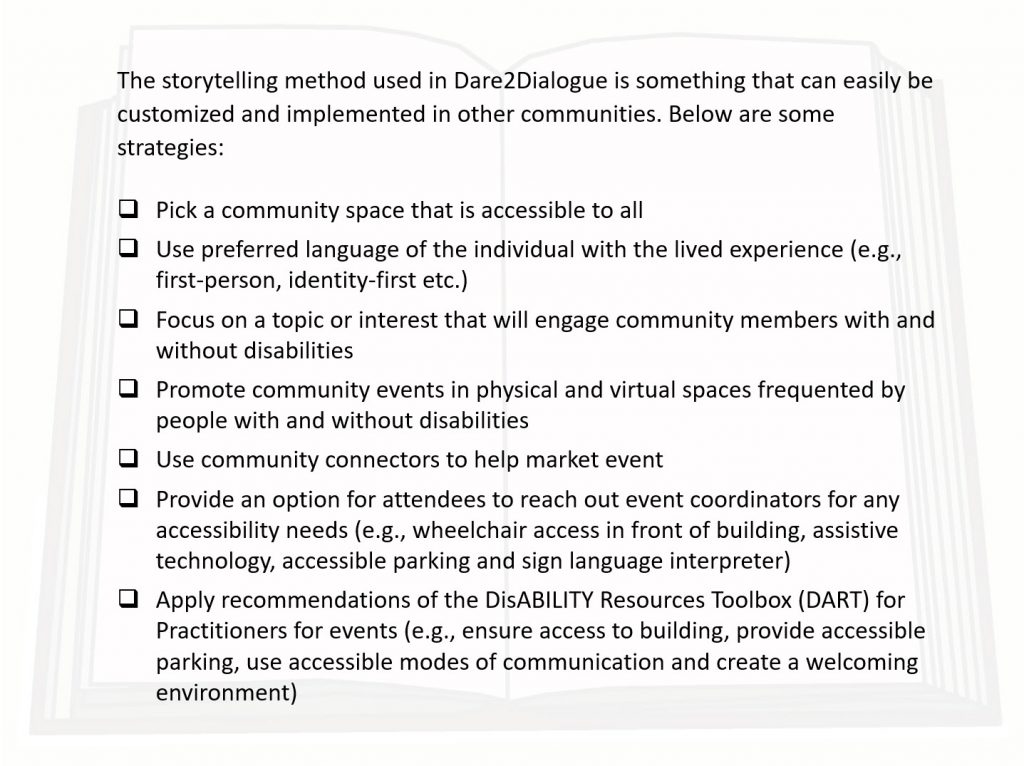
Conclusion
We must create and hold space for people living with disabilities whenever we can. We read somewhere that “diversity is inviting people differently in every facet (e.g. ethnically, age, religion or spirituality, physical or mentally diverse, etc.) to the party, but “inclusion” is when they show up, you ask them to dance. We understand that some people living with a disability cannot physically stand up to dance or cognitively grasp what this means, but in this context, we mean “dance” as a metaphor for “engage in “building a relationship or community.”
DisABILITY Resources Toolbox (DART) for Practitioners
From Theory to Practice Reflections and Questions
- What does the inclusion of individuals living with a disability mean to you?
- What feelings surface for you when you think about becoming involved in community building alongside people living with any type of disability?
- In order to promote inclusion for people with disabilities, it is imperative that we create spaces and opportunities in the community to make sure their voices are not only heard but are the focus of the conversation. How would you create spaces and opportunities in the community to make sure their voices are not only heard but are the focus of the conversation?
References
Ten facts on disability. (2017). https://www.who.int/features/factfiles/disability/en/
ASDC for the Community Foundations/Intergroup Relations Program (1999). Principles for Intergroup Projects: A First Look.
Bailey, P.H. & Tilley, S. (2002). Storytelling and the interpretation of meaning in qualitative research. Journal of Advanced Nursing, 38, 574-583. https://doi.org/10.1046/j.1365-2648.2000.02224.x
Bialik, K. (2020). 7 facts about Americans with disabilities.
Carter, E. W., & Bumble, J. L. (2018). The promise and possibilities of community conversations: Expanding opportunities for people with intellectual and developmental disabilities. Journal of Disability Policy Studies, 28, 195–202. https://doi.org/10.1177/1044207317739408
Disabled World. (2020). Invisible Disabilities: List and General Information.
Dunn, D. S., & Andrews, E. E. (2015). Person-first and identity-first language: Developing psychologists’ cultural competence using disability language. American Psychologist, 70(3), 255–264. https://doi.org/10.1037/a0038636
Noy, C. (2008). Sampling knowledge: The hermeneutics of snowball sampling in qualitative research. International Journal of Social Research Methodology, 11, 327–344. https://doi.org/10.1080/13645570701401305
Okoro, C.A., Hollis, N.D., Cyrus, A.C., & Griffin-Blake, S. (2018). Prevalence of disabilities and health care access by disability status and type among adults-United States, 2016. National Library of Medicine. https://pubmed.ncbi.nlm.nih.gov/30114005/
Prilleltensky, I., & Nelson, G. (1997). Community psychology: Reclaiming social justice. In D. Fox & I. Prilleltensky (Eds.), Critical psychology: An introduction. (pp. 166– 184). Sage Publications, Inc.

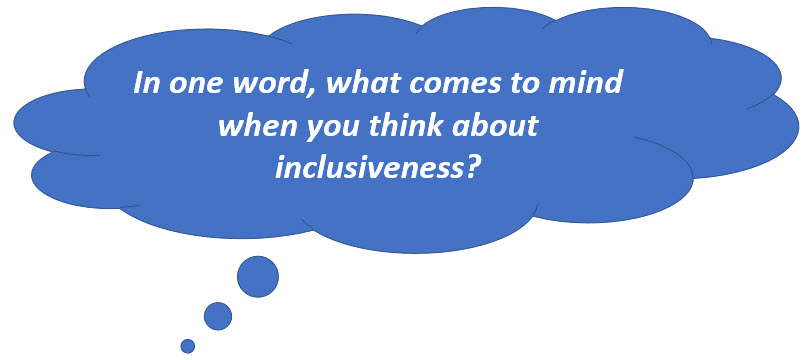

Feedback/Errata